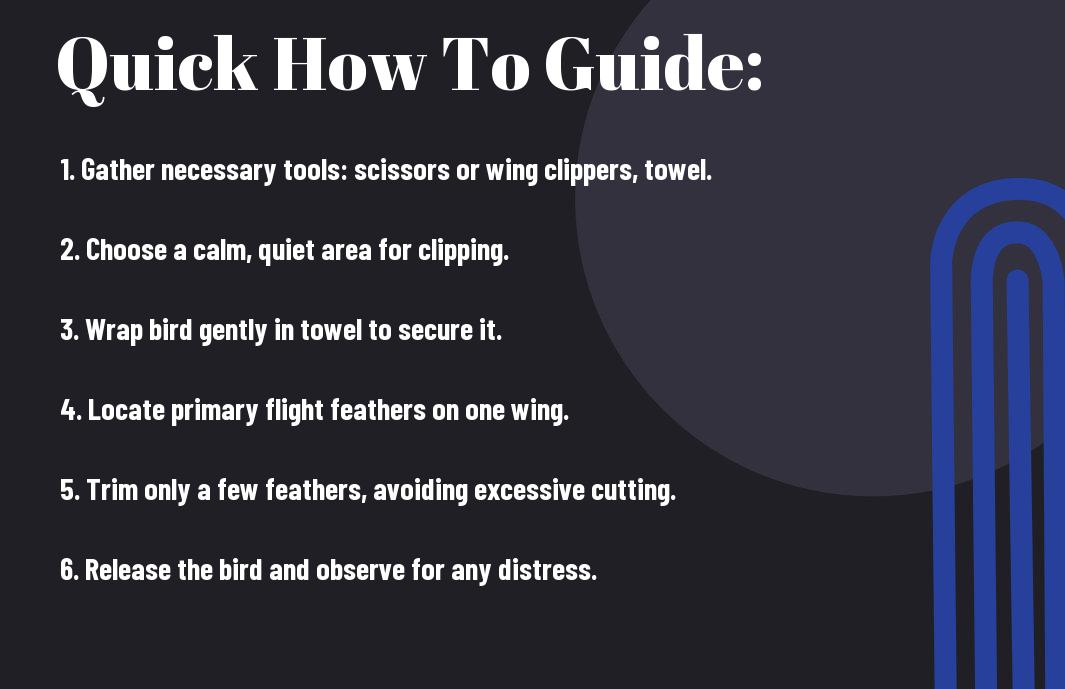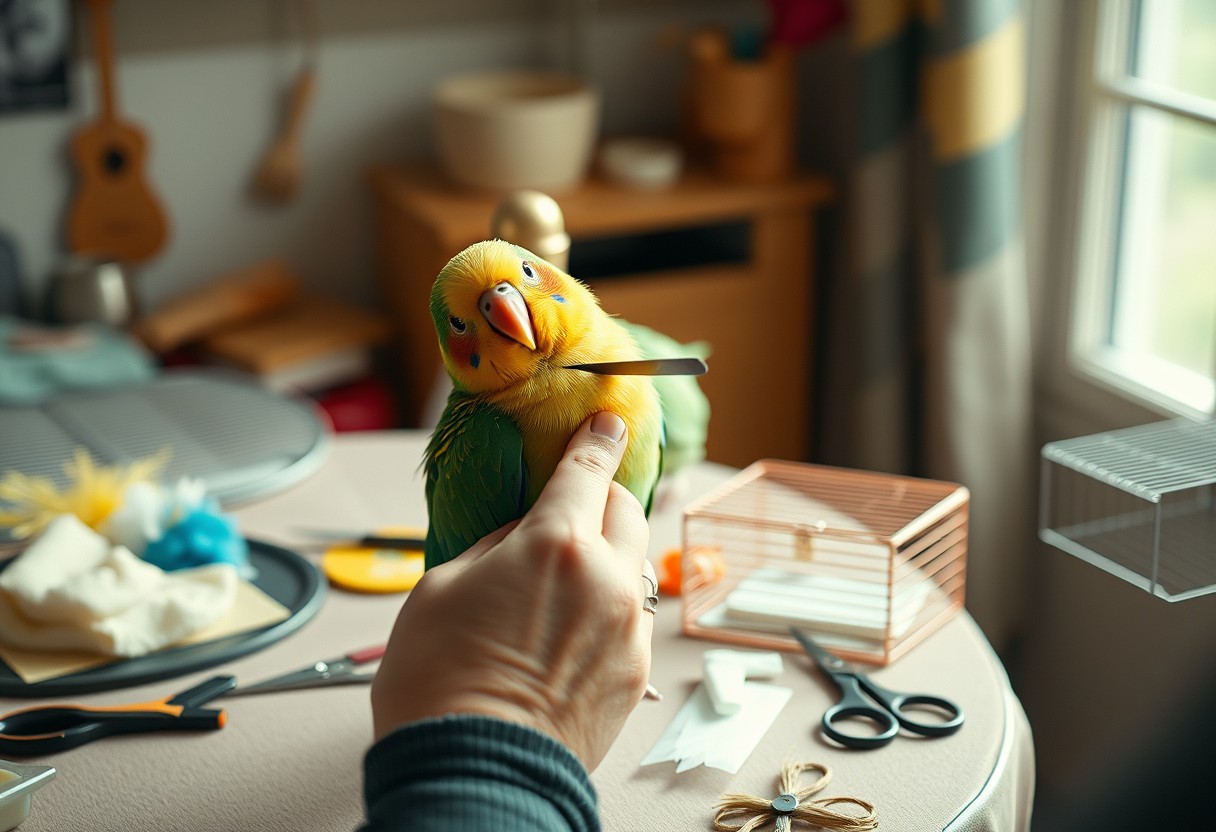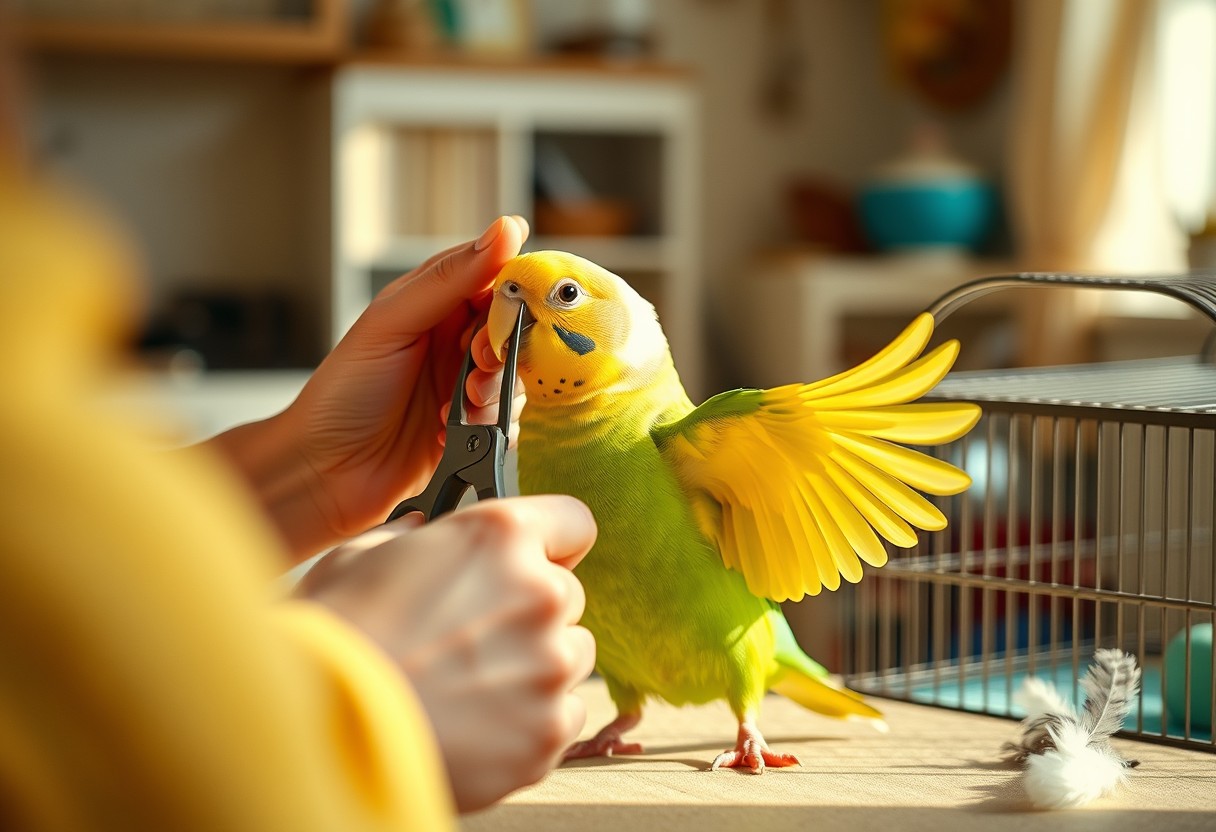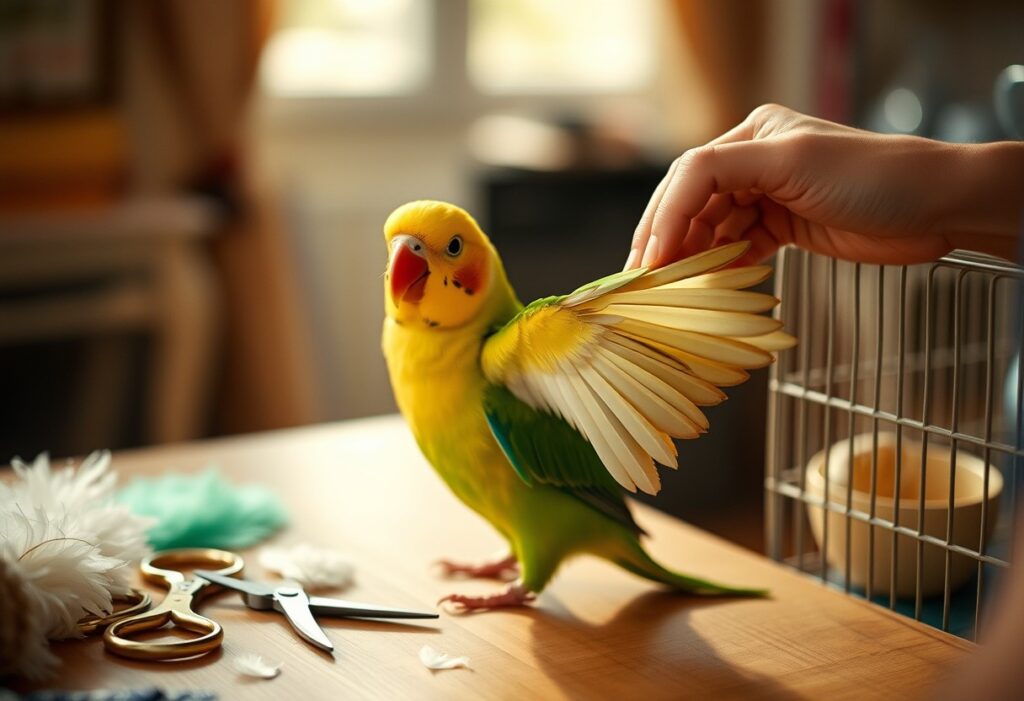Safely clipping your bird’s wings can greatly enhance their well-being and prevent unexpected accidents around the house. Understanding your bird’s anatomy and the correct techniques is crucial to avoid damaging blood feathers and to ensure a stress-free experience. In this guide, you will learn step-by-step instructions and tips to make the process smooth and effective, ultimately helping you maintain your bird’s safety while allowing them some freedom to explore their environment. Let’s explore the important details you need to know for this crucial task.

Understanding the Importance of Wing Clipping
While bird ownership presents a myriad of joys, it also comes with responsibilities, one of which is ensuring your feathered friend’s safety. Wing clipping is a common practice that helps to prevent your bird from flying into dangerous situations. This procedure can significantly reduce the risk of injuries associated with flying accidents, such as collisions with windows, ceiling fans, or even escape attempts that might lead to the bird getting lost outside. By carefully managing your bird’s ability to fly, you create a safer environment for both your pet and your household.
Why Clip a Bird’s Wings?
Understanding the reasons behind wing clipping is important for any bird owner. One of the primary purposes of this practice is to maintain control over your bird’s movements. By clipping your bird’s wings, you can keep it from flying into harmful areas of your home where it could sustain injuries. Additionally, it can prevent escapism; curious birds often find open windows or doors and can easily fly away, putting them in perilous situations. Thus, wing clipping serves as both a protective measure and a way to foster a close bond between you and your pet.
However, it is important to note that wing clipping should not be viewed as a long-term solution to behavioral issues, such as aggression or stress. It is crucial to combine this practice with proper training and environmental enrichment. Ultimately, the goal is to ensure your bird can safely enjoy its surroundings while remaining secure in your care.
Factors to Consider Before Clipping
The decision to clip your bird’s wings should not be taken lightly. There are several important factors to consider before proceeding with this procedure. You need to reflect on your bird’s overall health and temperament, as well as the specific needs of its species. For instance, species such as cockatiels and budgerigars might require different clipping techniques compared to larger birds like macaws. Furthermore, consider how clipping may affect your bird’s behavior; while it can create a safer environment, it may also lead to frustration or stress if not done correctly.
- Health: Your bird’s physical condition can influence how and whether to clip its wings.
- Species: Different species may require unique approaches to wing clipping.
- Behavior: Monitor how your bird may react after clipping, including stress levels.
Importance lies in understanding the nuances surrounding wing clipping. By carefully weighing the benefits against the risks, you can ensure a positive experience for both you and your bird. Acquiring accurate information on your pet’s specific needs will greatly contribute to making an informed decision about this practice. Recognizing these factors can help you create a harmonious, safe living environment for your bird.
Factors such as your bird’s age, the environment, and your available time for training should also be top of mind before you clip. For example, younger birds often adapt better to wing clipping as compared to older ones that may have been flying freely for years. Additionally, if you live in a multi-level home or one with many open spaces, this could increase the likelihood of accidents if your bird is not clipped. Understanding the environment in which your bird lives can critically impact your decision. Recognizing how these aspects interplay can guide you in making the best choice for your feathery companion.

Preparing for the Clipping Process
Little do many bird owners know, proper preparation is key to ensuring a safe and stress-free wing clipping experience for both you and your feathered friend. Before entering into the clipping process, it’s vital to gather the right tools, create a comfortable environment, and carefully choose the timing for the procedure. Taking these preparatory steps can minimize the risks associated with clipping and help to maintain trust between you and your pet.
Necessary Tools for Clipping
The first step in preparing for the clipping process is to assemble the necessary tools. You will need a sharp pair of bird scissors or shears specifically designed for wing clipping, as these tools allow for a clean and precise cut. Additionally, having a comfortable perch or table where you can hold your bird securely will help to keep it stable during the process. It is also wise to have a towel handy to wrap your bird gently if it becomes overly anxious or begins to flutter.
Another useful tool is a styptic powder, in case of any accidental bleeding from the clipped feathers. This powder can help quickly clot the blood and prevent further bleeding, which is crucial in an emergency. Finally, consider incorporating treats to reward your bird throughout the process, as this can help create a positive association with wing clipping and alleviate some stress for both you and your pet.
Choosing the Right Time
Any successful clipping process relies heavily on choosing the right time to start. Finding a moment when your bird is calm and relaxed can significantly influence how well the session goes. Preferably, select a time when your bird is less active, such as after a meal or during its usual resting period. Avoid times when it is feeling anxious or excited, as this may lead to more aggressive movements and an increased likelihood of injury.
It is advisable to observe your bird’s behavior and natural routines to identify the ideal moment for clipping. Knowing your bird’s personality can also aid in this decision-making process. For instance, if your bird enjoys quiet moments in the early evening or during a nap, it may be best to schedule the clipping then. Remember that patience and understanding are vital; rushing the process can lead to unease and may put both you and your bird at risk.

Step-by-Step Guide to Clipping Wings
Clipping your bird’s wings at home can be a straightforward process when approached correctly. This guide will help you safely navigate through each step, ensuring a stress-free experience for both you and your feathered friend.
| Step | Description |
|---|---|
| 1. Prepare Your Tools | Gather sharp, clean scissors or a pair of avian nail trimmers specifically designed for birds. |
| 2. Handle Your Bird Calmly | Ensure your bird is calm and relaxed before you begin clipping. This reduces the risk of stress and injury. |
| 3. Identifying the Flight Feathers | Know which feathers to clip to achieve the desired effect without harming your bird. |
| 4. How to Properly Clip the Feathers | Follow the steps for clipping carefully, ensuring you cut only the right feathers. |
| 5. Monitor Your Bird | After clipping, allow your bird time to adjust and monitor for any signs of discomfort or stress. |
Handling Your Bird Calmly
Now, before you attempt to clip your bird’s wings, it’s crucial to handle your bird calmly. Birds can sense your stress and anxiety, which may make them anxious as well. Spend some time interacting with your bird, allowing it to get comfortable with you. This can be through gentle petting, talking softly, or letting it sit on your hand. The more relaxed your bird is, the easier the clipping process will be.
In addition to creating a calm environment, consider choosing a safe space for the clipping session. This should be a quiet area with minimal distractions. Ensure you have someone to help you if needed, as an extra pair of hands can help hold your bird securely without causing distress during the procedure.
Identifying the Flight Feathers
Wings are imperative for your bird’s movement and navigation, and knowing which feathers to clip is critical. Flight feathers are the long, stiff feathers located on the outer wing. These feathers provide lift and are imperative for flying. It’s important to locate the primary flight feathers, which are the first ten feathers closest to the wingtip and tend to be longer and broader.
To assist with identifying these feathers, you might consider using a flashlight to look closely at your bird’s wing. Take your time and make sure you differentiate between the flight feathers and contour feathers, which are shorter and provide insulation but are not imperative for flight.
How to Properly Clip the Feathers
Wings should be clipped correctly to ensure your bird can still glide safely but not fly high enough to escape or get into dangerous situations. Start by gently holding your bird in a secure position but avoid applying too much pressure. Use one hand to support the body while the other hand positions the wing for clipping. This will allow you to see the flight feathers more clearly.
Once located, use your scissors or trimmers to clip the flight feathers, making sure to cut only the primary feathers and leave the secondary feathers intact. This will help maintain your bird’s balance and allow it to navigate safely on the ground. Be sure to do this quickly and with confidence to minimize any discomfort for your pet.
StepbyStep, always double-check before clipping to ensure that you are not cutting too close to the skin, which could lead to bleeding. If in doubt, it may be best to consult with a veterinarian or a professional bird groomer before attempting the clipping, especially the first time.
Tips for a Safe and Stress-Free Experience
Keep your bird’s safety and comfort as your top priority throughout the wing clipping process. Here are some key tips to ensure a smooth and stress-free experience:
- Prepare a quiet area free from distractions.
- Use proper tools such as avian nail clippers or sharp scissors.
- Have a friend assist you to keep the bird calm and secure.
- Choose a time when your bird is naturally calm, such as after a meal.
- Be gentle and patient throughout the clipping process.
After all these preparations, you’ll set the stage for a much smoother experience for both you and your feathered friend.
Monitoring Your Bird’s Behavior
One important aspect of safely clipping your bird’s wings is to closely monitor its behavior before and after the procedure. Pay attention to any signs of stress, such as flapping, vocalizing loudly, or attempting to escape. Understanding your bird’s temperament can help you gauge its comfort level and make adjustments accordingly. If your bird tends to become agitated, consider taking breaks during the clipping process to allow it to relax.
One effective way to ease stress is by rewarding your bird with treats or affection during and after the clipping. This positive reinforcement helps to associate wing clipping with a pleasant experience, thereby reducing future anxiety. Always watch for signs of discomfort, and remember that if your bird appears overly distressed, consider stopping and rescheduling for another day.
Post-Clipping Care
An imperative part of wing clipping is ensuring that you care for your bird properly afterward. Once you’ve finished the process, give your bird some time to adjust to its new situation. Offer a quiet and safe space where it can recuperate without feeling threatened. Ensure that there’s plenty of fresh water and a light meal available, as your bird may be in need of comfort after the experience.
Monitoring your bird’s behavior in the days following the wing clipping is crucial. Make sure it remains calm and resumes its normal activities. If you notice any signs of distress or unusual behavior, such as excessive squawking or refusal to eat, reach out to a veterinarian for further advice. Providing your bird with love and patience can greatly aid in its recovery and help maintain a trusting relationship between the two of you.
To wrap up
With this in mind, safely clipping your bird’s wings at home can greatly enhance its well-being and safety. It’s necessary to gather the right tools, such as sharp, bird-safe scissors and a gentle grip, to minimize stress during the process. Always ensure that you are in a quiet and calm environment where your bird feels secure. Remember to assess your bird’s wing feathers and only trim the primary flight feathers, avoiding blood feathers to prevent any unnecessary bleeding or injuries. Finally, taking your time and being patient will help create a better experience for both you and your feathered friend.
Hence, wing clipping is a delicate task that should not be taken lightly. By adhering to these guidelines and taking the necessary precautions, you can carry out this task successfully and help create a safe space for your bird. Should you feel uncertain or uncomfortable about the process, consider consulting with a veterinarian or a professional avian groomer who can provide the guidance and help you need. Your bird’s health and safety should always be your top priority.
FAQ
Q: What tools do I need to safely clip my bird’s wings at home?
A: To safely clip your bird’s wings at home, you will need a pair of sharp, specialized bird scissors or a claw clipper designed for pets. It’s important to use tools that are appropriate for your bird’s size and type, as standard human scissors may not provide a clean cut. Additionally, prepare a comfortable and quiet space for the clipping process to minimize your bird’s stress during the procedure. Have some treats nearby to reward your bird after the clipping to create a positive association with the experience.
Q: How do I determine where to clip my bird’s wings?
A: When clipping your bird’s wings, you should focus on the primary flight feathers, which are the longest feathers located on the outermost part of the wings. These are typically the 5th to 10th feathers, varying depending on the species and size of your bird. It is crucial to avoid cutting too close to the body to prevent injury. If you’re unsure, consult a professional or refer to a guide specific to your bird species to identify the correct feathers to trim. Always remember to clip only one wing at a time to prevent your bird from becoming unbalanced.
Q: How can I make the wing clipping process less stressful for my bird?
A: To minimize stress during the wing clipping process, it’s necessary to create a calm and secure environment. Ensure that the room is quiet and free from distractions, and consider covering the cage or using a towel to gently wrap your bird if it seems more comfortable. Familiarize your bird with the grooming tools by allowing it to observe the tools in a non-threatening way beforehand. During the clipping, work slowly and gently, speaking softly to reassure your bird. After the clipping, reward your bird with a treat or praise to encourage a positive reaction to the grooming process.











